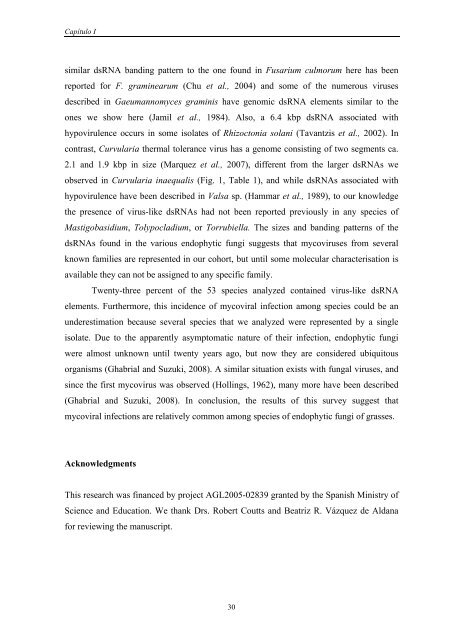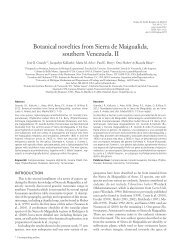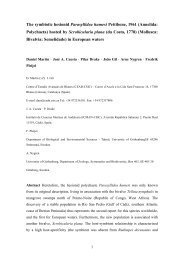TESIS NOEMI HERRERO.pdf - Consejo Superior de Investigaciones ...
TESIS NOEMI HERRERO.pdf - Consejo Superior de Investigaciones ...
TESIS NOEMI HERRERO.pdf - Consejo Superior de Investigaciones ...
Create successful ePaper yourself
Turn your PDF publications into a flip-book with our unique Google optimized e-Paper software.
Capítulo I<br />
similar dsRNA banding pattern to the one found in Fusarium culmorum here has been<br />
reported for F. graminearum (Chu et al., 2004) and some of the numerous viruses<br />
<strong>de</strong>scribed in Gaeumannomyces graminis have genomic dsRNA elements similar to the<br />
ones we show here (Jamil et al., 1984). Also, a 6.4 kbp dsRNA associated with<br />
hypovirulence occurs in some isolates of Rhizoctonia solani (Tavantzis et al., 2002). In<br />
contrast, Curvularia thermal tolerance virus has a genome consisting of two segments ca.<br />
2.1 and 1.9 kbp in size (Marquez et al., 2007), different from the larger dsRNAs we<br />
observed in Curvularia inaequalis (Fig. 1, Table 1), and while dsRNAs associated with<br />
hypovirulence have been <strong>de</strong>scribed in Valsa sp. (Hammar et al., 1989), to our knowledge<br />
the presence of virus-like dsRNAs had not been reported previously in any species of<br />
Mastigobasidium, Tolypocladium, or Torrubiella. The sizes and banding patterns of the<br />
dsRNAs found in the various endophytic fungi suggests that mycoviruses from several<br />
known families are represented in our cohort, but until some molecular characterisation is<br />
available they can not be assigned to any specific family.<br />
Twenty-three percent of the 53 species analyzed contained virus-like dsRNA<br />
elements. Furthermore, this inci<strong>de</strong>nce of mycoviral infection among species could be an<br />
un<strong>de</strong>restimation because several species that we analyzed were represented by a single<br />
isolate. Due to the apparently asymptomatic nature of their infection, endophytic fungi<br />
were almost unknown until twenty years ago, but now they are consi<strong>de</strong>red ubiquitous<br />
organisms (Ghabrial and Suzuki, 2008). A similar situation exists with fungal viruses, and<br />
since the first mycovirus was observed (Hollings, 1962), many more have been <strong>de</strong>scribed<br />
(Ghabrial and Suzuki, 2008). In conclusion, the results of this survey suggest that<br />
mycoviral infections are relatively common among species of endophytic fungi of grasses.<br />
Acknowledgments<br />
This research was financed by project AGL2005-02839 granted by the Spanish Ministry of<br />
Science and Education. We thank Drs. Robert Coutts and Beatriz R. Vázquez <strong>de</strong> Aldana<br />
for reviewing the manuscript.<br />
30

















